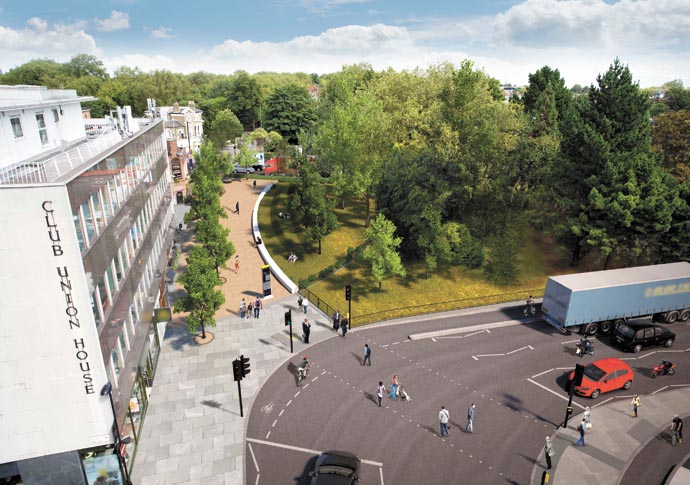Pedestrians will be losers at new-look Highbury Corner
Friday, 23rd March 2018

An artist’s impression of how the revamped Highbury Corner will look when finished
• I CANNOT agree that the present proposal for Highbury Corner is in line with the Mayor’s Transport Strategy or draft London Plan.
Both call for a modal shift so that by 2041, 80 per cent of journeys are made by sustainable means. For this to be achieved, walking, cycling and bus travel will have to be sufficiently attractive to persuade motorists out of their cars. The proposals as currently drawn up worsen conditions for pedestrians and bus users.
Walking comprises two distinct activities: a healthy stroll through the arboretum has its place, but it will be necessary to encourage more people to walk where previously they used a cycle, bus or car. It is these journeys that are made more difficult under the proposals.
Highbury Corner is first and foremost a major interchange, chiefly between bus and rail. Interchange is crucial to the attractiveness of public transport. Users like through journeys wherever possible.
Unless the interchange is seamless, it will dissuade potential users. This means minimising the distances necessary to walk between the two modes, and ensuring that all forward options are available from a single point.
Minimising distances is also operationally necessary when space is at a premium. A hundred people walking 200 yards take up four times the space of 100 people walking 50 yards.
Because the station entrance is on the west side, it is essential that buses continue to serve the western arm. As we drive on the left, it is also preferable from a bus operational point of view.
Although there used to be access to part of the station from the east side of Holloway Road, it is not practical to reopen this entrance, still less to link it to the Overground platforms.
It is also desirable, where the volume of usage justifies it, to have a choice of two bus routes, to minimise the delay when, for example, the 30 service is disrupted at Baker Street.
The idea that extra buses on the 30 would make up for the loss of the 277 is laughable. The 277 would save three or four buses by turning short at Dalston. These buses on the 30 would improve its frequency at best by 10 per cent.
The 277 provides more than 50 per cent of the current service along St Paul’s Road. This is why Hackney Council is campaigning vigorously for its retention.
It will have seen the reaction of Haringey residents to the disastrous scheme at Archway, where changing buses is no longer possible and those arriving by tube have a longer walk and only a 50 per cent chance of locating the first available bus for their onward journey.
The last Mayor refused to countenance any reduction in private vehicular traffic and as a result cycle lanes were introduced at the expense of bus lanes. The result was a decline in bus usage at a time when the population, certainly, and the economy, reportedly, were growing.
We have to reverse that trend if Transport for London’s ambitious plans are to be funded, not by turning our backs on cyclists, but by confronting the need to reduce road space given over to private vehicles.
ANDREW BOSI
Wall Street, N1